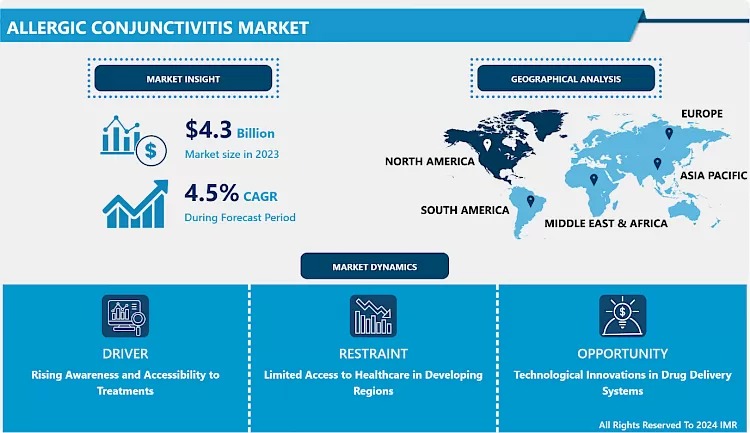-
Fil d’actualités
- EXPLORER
-
Pages
-
Blogs
-
Courses
-
Film
Allergic Conjunctivitis Market to Hit $6.39B by 2032

(IMR) today released a comprehensive analysis of the Global Allergic Conjunctivitis Market, forecasting growth from USD 4.3 billion in 2023 to USD 6.39 billion by 2032, at a compound annual growth rate (CAGR) of 4.5% over the 2024–2032 period.
This growth is being fueled by increasing global incidence of allergic eye disorders, rising environmental allergen exposure, and growing adoption of both over-the-counter (OTC) and prescription therapies. In addition, digital lifestyle trends — particularly more screen time — are exacerbating eye strain and allergy symptoms, further spurring demand.
Quick Insights
- 2023 Market Size: USD 4.3 Billion
- 2032 Forecast: USD 6.39 Billion
- Forecast CAGR (2024–2032): 4.5%
- Types Covered: Seasonal Allergic Conjunctivitis (SAC), Perennial Allergic Conjunctivitis (PAC)
- Treatment Segments: Antihistamines, Mast Cell Stabilizers, NSAIDs, Corticosteroids, Others
- End Users: Hospitals, Ophthalmology Clinics, Home Care Settings
- Leading Region: North America, due to strong healthcare infrastructure and high access to allergy therapies
- Key Players: AbbVie; Alcon; Bausch & Lomb; Johnson & Johnson Vision Care; Meda Pharmaceuticals; Novartis; Ocular Therapeutix; Regeneron; Sanofi; Santen Pharmaceutical
Market Drivers & Dynamics
- Rising Allergy Burden: Increasing exposure to allergens such as pollen, dust mites, pet dander, and pollutants is raising the prevalence of allergic conjunctivitis.
- Digital Eye Strain: More time spent on digital devices is intensifying eye irritation and allergic responses, increasing demand for eye allergy treatments.
- Better Access & Awareness: Greater availability of OTC antihistamines and prescription therapies is boosting treatment uptake.
- Innovation in Drug Delivery: Biologic agents (e.g., monoclonal antibodies) and more targeted delivery systems are emerging, promising more effective and safer allergy therapies.
What’s Next: Opportunities & Emerging Trends
Could biologics and tailored allergy diagnostics reshape allergic conjunctivitis treatment?
- The development of monoclonal antibodies targeting allergic pathways promises more precise, durable control of symptoms.
- Advanced diagnostics that identify specific allergens in individual patients could enable personalized therapy, improving outcomes and minimizing side effects.
- There is also growing consumer interest in natural or “mild” treatments, such as herbal remedies or non-pharmacological approaches, opening new market segments.
Expert Voice
“The allergic conjunctivitis market is evolving from a traditional eye-drop model toward highly targeted therapies and diagnostics,” said Dr. Neelima Rao, Principal Consultant, Pharmaceutical & Ophthalmic Research at.
“As digital lifestyles increase screen exposure, and as allergy prevalence rises globally, demand for more effective, patient-friendly, and personalized solutions is accelerating. Companies that innovate around biologics and long-term control will likely gain a competitive edge.”
Regional & Segment Analysis
- North America: Expected to remain the largest regional market, driven by high awareness, strong distribution networks, and a robust regulatory environment.
- Asia-Pacific: Presents high-growth potential, especially in urban hubs, where rising pollution and allergen exposure coincide with improving healthcare access.
- Europe: Growth is supported by well-established ophthalmic care infrastructure and rising demand for both prescription and OTC allergy treatments.
- By Type: Seasonal allergic conjunctivitis (SAC) dominates due to its widespread prevalence.
- By Treatment: Antihistamines hold the largest share because of their rapid relief; mast-cell stabilizers and corticosteroids remain significant for long-term management.
- By End User: Hospitals and ophthalmology clinics account for most of the prescription-based market; meanwhile, home care (OTC) is growing quickly.
Breakthroughs & Latest Developments
- Several companies are investing in monoclonal antibody therapies for allergic conjunctivitis, aiming at long-term, low-frequency dosing.
- Regional players are expanding distribution networks, especially in Asia-Pacific, to reach allergy patients in both urban and rural areas.
- There is an increasing trend toward sustainable and natural allergy relief products, such as homeopathic formulations, as patient preference shifts.
- Diagnostic innovation: New point-of-care tools are emerging to better profile patient allergens and guide treatment customization.
Challenges & Cost Pressures
- Access Disparities: In many developing regions, access to prescription eye allergy therapies remains limited, which restricts market penetration.
- Treatment Adherence: Chronic allergic conjunctivitis may require long-term therapy, but patient adherence to medications (especially prescription ones) can be inconsistent.
- Regulatory & Development Risk: Developing biologics or novel drug-delivery systems involves high R&D costs, stringent regulatory requirements, and longer time to market.
- Generic Competition: Generic antihistamines and mast-cell stabilizers may put pricing pressure on branded products.
Case Study: Improving Patient Outcomes Through Tailored Therapy
A leading eye-care clinic in North America piloted a diagnostic-guided treatment program for patients with recurrent allergic conjunctivitis. By using allergen profiling and personalized prescriptions (antihistamine vs. mast-cell stabilizer vs. combination), they achieved:
- 30% fewer flare-ups in treated patients
- Higher patient satisfaction due to fewer side effects
- Better long-term adherence because of a tailored therapeutic regimen
- Reduced visits to emergency or clinic settings, lowering overall treatment burden
Call to Action
To access a free sample or to discuss customized insights from our Allergic Conjunctivitis Market Report, please:
- Download Sample Report: – Allergic Conjunctivitis Market https://introspectivemarketresearch.com/reports/allergic-conjunctivitis-market/
- Schedule a Strategy Call: Email sales@introspectivemarketresearch.com or call +91-74101-03736 / +91-95790-51919
About
(IMR) is a global, full-service market intelligence firm specializing in pharmaceuticals, life sciences, and healthcare. Through deep expertise, rigorous methodology, and forward-looking analysis, IMR empowers decision-makers to navigate complex markets and capture growth opportunities.
Media Contact
Phone: +91-74101-03736 | +91-95790-51919
Email: press@introspectivemarketresearch.com
Website: introspectivemarketresearch.com
- allergic_conjunctivitis_market
- eye_allergy_treatment
- antihistamine_eye_drops
- ocular_allergies
- seasonal_allergic_conjunctivitis
- perennial_allergic_conjunctivitis
- ophthalmic_drugs_market
- allergy_therapeutics
- ocular_inflammation_treatment
- biologics_for_eye_allergies
- eye_care_market
- allergy_diagnostics
- conjunctivitis_prevalence
- ophthalmology_market_research
- IMR_market_report
- healthcare_market_analysis
- pharmaceutical_market_trends
- OTC_eye_allergy_products
- digital_eye_strain_solutions
- allergic_conjunctivitis_forecast
- Art
- Causes
- Crafts
- Dance
- Drinks
- Film
- Fitness
- Food
- Jeux
- Gardening
- Health
- Domicile
- Literature
- Music
- Networking
- Autre
- Party
- Religion
- Shopping
- Sports
- Theater
- Wellness


